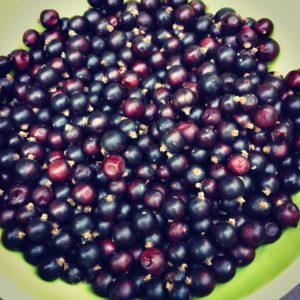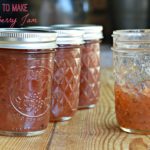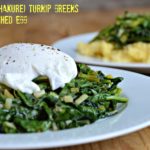I stood in front of the table of fruit deep in thought: three kinds of currants — white, red and black — plus gooseberries! Another vendor a few tables over had four or five small boxes of hard-to-find tayberries. What to get? It was an embarrassment of riches. So much fruit! So many unusual and old-fashioned crops that you never see at the supermarket. But I didn’t have money for all of them, let alone time to eat or cook with them all. After a lot of internal debate — gooseberries taste funny, I bought red currants last time, the tayberries are outrageously dear — I ended up with three pints of gorgeous, inky black currants.
I love tart, tiny currants. They are foreign to most Americans — one friend told me she had never tried a currant until today. But the Europeans still eat — and drink — them frequently. The French, for example, make a delicious liqueur out of black currants called Crême de Cassis. Mixed with white wine or champagne, cassis makes a refreshing apératif called a Kir (or a Kir Royale if its champagne.) Fresh currants are not to be confused with the small dried fruit of the same name, which are more like a grape. Currants are a berry and grow on shrubs, not vines like grapes do. (Dried currants were once small grapes.) When I researched currants for this post, I learned that one of the reasons that modern-day Americans know so little about currants is that it was illegal to grow them from the early 1900’s until 1966. The federal government was concerned that currants and other plants in their genus were hosts for a devastating disease that was infecting pine trees. But when the government realized that the plant was still growing wild and that was by far the greater threat, the ban on commercial cultivation of currants was lifted.
As one might guess from their bright colors, currants are packed with nutrients, including vitamin C, potassium, magnesium, zinc, folic acid, vitamin A and flavenoids. Black currants, which have an intense blue-black hue, have been shown to act as an anti-inflammatory and to stimulate the immune system and fight infection. No wonder they are so popular in northern and eastern European cuisine. While these little powerhouses may be too tart to eat out of hand like a berry, they are wonderful in baked goods, especially when mixed with other fruits, or preserved as a jam or syrup. Raspberries and red currants, for example, are a dynamite combination for a cobbler or a jam. I have made black currant jam in the past and it is absolutely delicious.
Currants can be a bit of a chore to deal with. It is important to remove their tiny stems before cooking because the stems can impart a bitter flavor. Currants can also make baked goods or preserves seedy. That is one reason to use a small amount of them and mix them with other fruits. To make currant jam, you actually need to cook the currants with water first, crushing their skins, and then you make the jam with the remaining pulp. This time around, I decided I wanted to make a black currant cordial rather than a jam because drink syrups are my latest obsession. Of course, a cordial requires even more work. The currants have to be cooked and then strained through a jelly bag so the juice drips into a bowl over the course of several hours. The juice is then cooked with sugar and lemon juice to make a refreshing cordial. I am excited to try the black currant cordial with sparkling water or, better yet, white wine. My recipe says that the syrup, undiluted, can also soothe a sore throat or cough — something to try in winter.
Are you familiar with currants? Have you cooked with them?
Much of the information about currants was gleaned from The Joy of Jams, Jellies and other Sweet Preserves by Linda Ziedrich.






